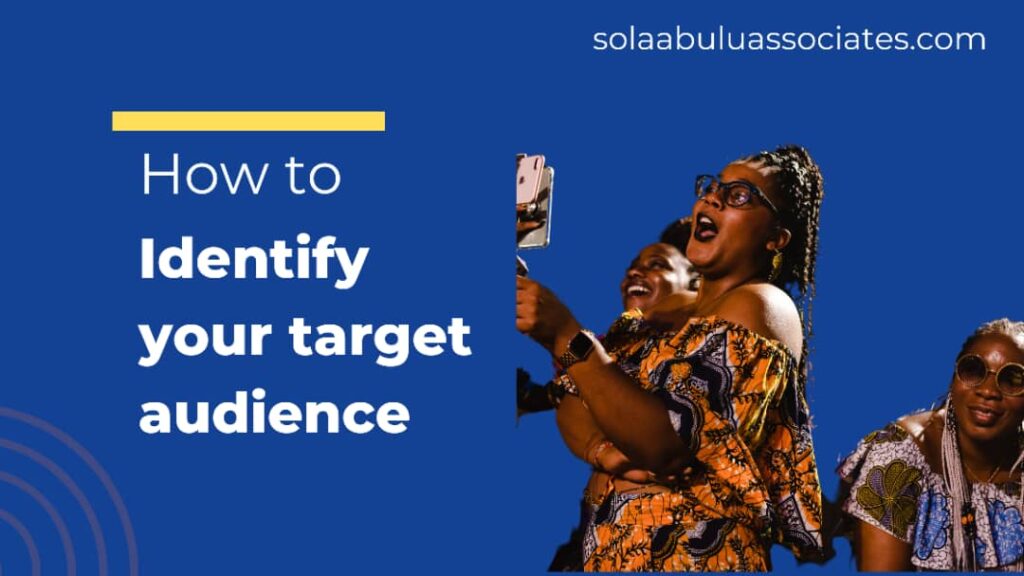How to Identify Your Target Audience

Everything about communications, engagement, and messaging starts and ends with an audience but many communications professionals are yet to understand the importance of getting their audience right. Identifying your target audience is crucial to achieving your objectives.
To identify your target audience, outline what your business/organizational or brand objectives are. If the communications effort is a campaign for an event, define the objectives. Is the aim to influence, inform, persuade or sell a product? Basically, what is the call to action? This must be very clear.
An objective is tied to something very tangible like awareness, advocacy, sales support, etc. It is in understanding your objectives that it is then easy to identify the target audience and be strategic enough to achieve outcomes.
Very importantly, a target audience cannot be the general public, especially when it is not in the case of public sector communication. There are specifics to it like age range, location, societal class, gender, professional status, etc. These can be referred to as the audience segment and they should be clearly spelt out to be strategic and purposeful with your communication.
“…getting a strong sense about your audience is the most effective way to ensure that your communication lands as intended and achieves the desired outcomes.” ~Sola Abulu.
when seeking to identify your target audience, the next step is profiling. In checking out an audience profile, you take the segments as highlighted earlier and examine their interests, concerns, mindsets, belief systems, value drivers and perspectives. A lack of these perspectives can result in a fruitless communication because you are unlikely to pass your message in a way that resonates with the identified target audience.
In many African countries, the public sector is lagging in this. A way to analyze this is when a message is communicated to citizens by government spokespersons and the responses are a reaction of anger and an outburst of rage, the communications effort did not achieve its intent. A typical example is the recent protest in Kenya due to the finance bill. Institutional organizations especially government bodies make the mistake of profiling only a certain audience (party members or elite citizens). This is why their communications may seem to achieve their outcome with one audience alone, leaving out the poor/middle class who form the majority.
The video below explains the importance of your target audience.
Your audience reserves the right to have their opinion on whatever message you share once it is communicated publicly. This is one of the perks of communicating in the digital age through social media because even when communications is not targeted at a certain audience, they have the right to share their views on the campaign.
In understanding your audience, it is also needful to know what platforms works best for them and can achieve your desired outcome. Be aware of the wider context and peculiarity of each platform. For example, Twitter can be described as the bedrock of activism while people who may be looking to grow a reputable brand are more carefree on Instagram and Facebook.
The next step reviewing your objectives and your call to action for the audience. After segmenting and profiling your audience, what do you want the audience to do? If the communication was not just for information alone, then there is an expected response you should look out for. It could be to enroll, sign up or register for something. If the objective was to advocate, then there should be a change of mindset towards the subject matter. An example is communicating around public health subject areas like the COVID vaccination. The aim will be to make people more cautious about using their face masks, hand sanitizers, etc.
The covid example shows how communication can fail if all the audience segments are treated the same way. There is a certain group of people who are not reluctant to messages on vaccination but communications of such campaign is tailored for all classes of audience. So, the channels to reach the less educated masses should differ to achieve its result. This is the same application that can be given to communications in the context of personal or corporate brands that are more targeted. Overall, the brand strategy should be robust enough to carry everyone along.
Don’t take your audience for granted. In today’s world where people have access to information more freely than ever, they don’t just trust brands because they exist or invest in high-level marketing. Your brand strategy must ensure that the communications and messaging bridge the gap. This is why understanding and identifying your target audience cannot be over-emphasized because it is possible to communicate with an audience that shares an entirely different view from the brand without being antagonistic.
We have announced enrolment for the next cohort of our Brand Strategy and Marketing Communications course. This course will help African brands to grow as an asset that enables them to achieve their full potential.
………………………………………………………………………………….
Sola Abulu & Associates is a strategy and communications consulting and training firm committed to enabling businesses, brands and organizations to achieve their objectives through strategic communications, organizational effectiveness and reputation risk management
Chat with us for more information on our courses.
